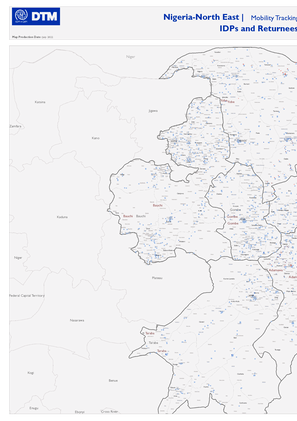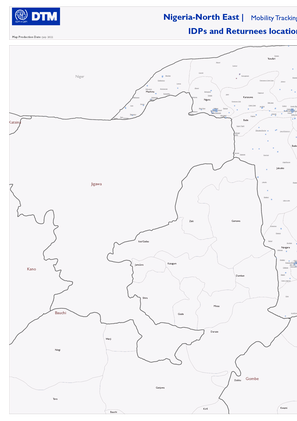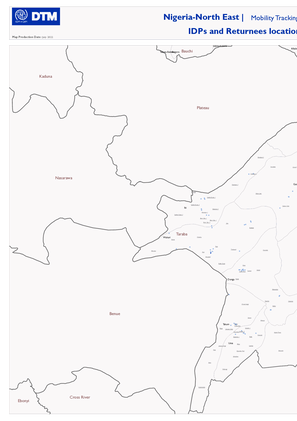-
Countries
-
Data and Analysis
-
Special Focus
-
Crisis Responses
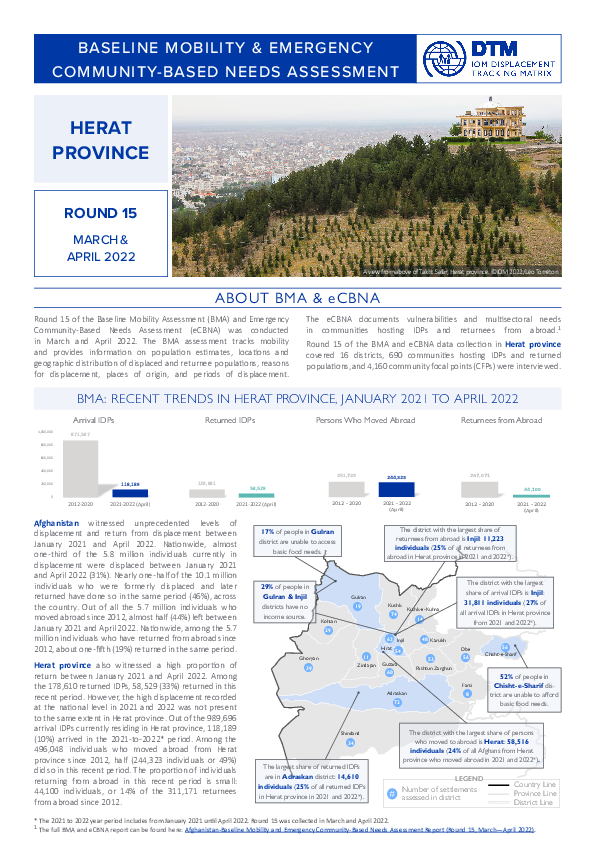
Contact
DTMAfghanistan@iom.int
Language
English
Location
Afghanistan
Period Covered
Mar 01 2022
Apr 30 2022
Activity
- Mobility Tracking
- Site Assessment
- Baseline Assessment
DTM has been conducting the Baseline Mobility Assessment in Afghanistan since 2016 to track mobility, provide information on population estimates, locations and geographic distribution of displaced and returnee populations, reasons for displacement, places of origin and periods of displacement. Vulnerabilities and multi-sectoral needs are covered in the Emergency Community- Based Needs Assessment (eCBNA) at the end of the report. Data is collected at the settlement level, through focus group discussions with community focal points and direct observations.
This province highlight delves into the key findings in Herat province using the latest results from Round 15 of the BMA and eCBNA (conducted in March and April 2022), focusing on the 2021-to-2022 period. The full report can be found here: Baseline Mobility and Emergency Community-Based Needs Assessment Report (Round 15, March—April 2022)
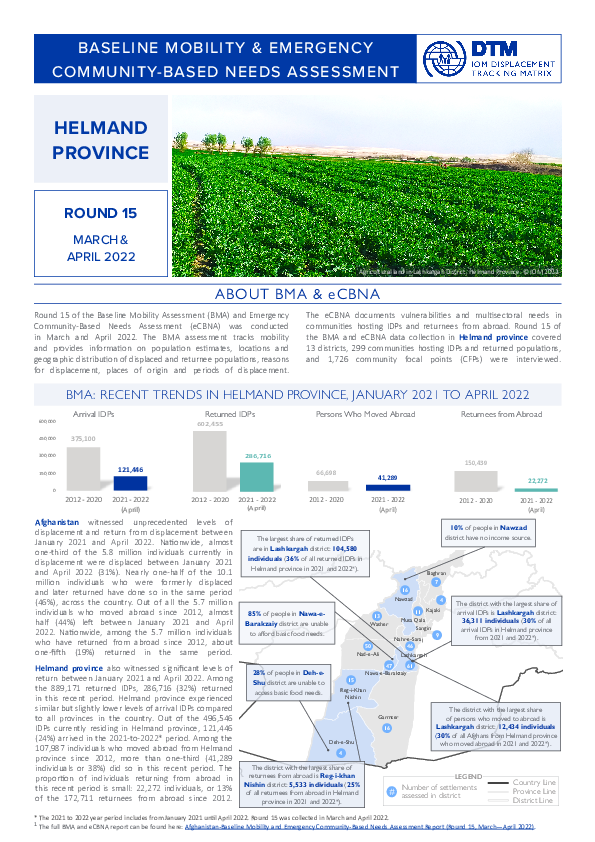
Contact
DTMAfghanistan@iom.int
Language
English
Location
Afghanistan
Period Covered
Mar 01 2022
Apr 30 2022
Activity
- Mobility Tracking
- Site Assessment
- Baseline Assessment
DTM has been conducting the Baseline Mobility Assessment in Afghanistan since 2016 to track mobility, provide information on population estimates, locations and geographic distribution of displaced and returnee populations, reasons for displacement, places of origin and periods of displacement. Vulnerabilities and multi-sectoral needs are covered in the Emergency Community- Based Needs Assessment (eCBNA) at the end of the report. Data is collected at the settlement level, through focus group discussions with community focal points and direct observations.
This province highlight delves into the key findings in Helmand province using the latest results from Round 15 of the BMA and eCBNA (conducted in March and April 2022), focusing on the 2021-to-2022 period. The full report can be found here: Baseline Mobility and Emergency Community-Based Needs Assessment Report (Round 15, March—April 2022)
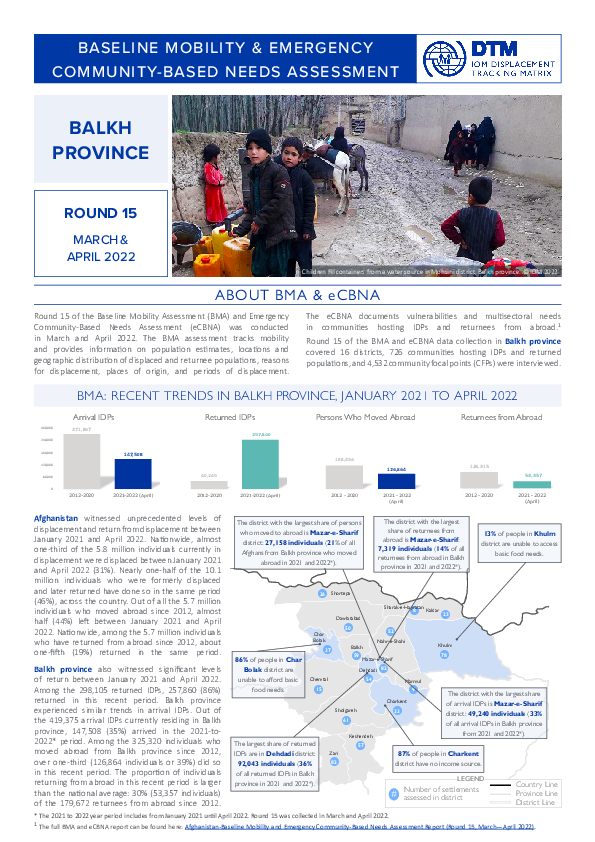
Contact
DTMAfghanistan@iom.int
Language
English
Location
Afghanistan
Period Covered
Mar 01 2022
Apr 30 2022
Activity
- Mobility Tracking
- Site Assessment
- Baseline Assessment
DTM has been conducting the Baseline Mobility Assessment in Afghanistan since 2016 to track mobility, provide information on population estimates, locations and geographic distribution of displaced and returnee populations, reasons for displacement, places of origin and periods of displacement. Vulnerabilities and multi-sectoral needs are covered in the Emergency Community- Based Needs Assessment (eCBNA) at the end of the report. Data is collected at the settlement level, through focus group discussions with community focal points and direct observations.
This province highlight delves into the key findings in Balkh province using the latest results from Round 15 of the BMA and eCBNA (conducted in March and April 2022), focusing on the 2021-to-2022 period. The full report can be found here: Baseline Mobility and Emergency Community-Based Needs Assessment Report (Round 15, March—April 2022)

Contact
DTM Europe, DTMMediterranean@iom.int
Language
English
Location
Bosnia & Herzegovina
Snapshot Date
Jul 21 2022
Activity
- Migrants presence
- Mobility Tracking
On 21 July 2022, the fourteenth joint data collection exercise was conducted by IOM Bosnia and Herzegovina (BiH), together with the Service for Foreigners’ Affairs (SFA), and with the support of the Red Cross Society BiH (RCSBH), to collect information on the number of migrants and asylum-seekers present in the country. The purpose of the regular exercise is to provide an estimation of the migrant population (stock) that is not accommodated or registered in any official Temporary Reception Centres (TRCs) at any given date.
Fourteen teams were deployed with a total of 35 enumerators (28 males and 7 females), plus 13 SFA staff (11males and 2 females) and 17 RCSBH staff (13 males and 4 females). The data collection exercise was implemented in 7 Cantons of Federation of Bosnia and Herzegovina (FBiH) and in 48 locations in the RS entity. A total of 240 locations3 in 50 different municipalities were visited: 76 locations in 5 municipalities in Una-Sana Canton, 39 locations in 6 municipalities in Sarajevo Canton, 32 locations in 10 municipalities in Tuzla Canton, 37 locations in 5 municipalities in Herzegovina-Neretva Canton, 4 locations in 4 municipalities in West Herzegovina Canton, 3 locations in 1 municipality in Bosnian Podrinje Goražde Canton, and 1 location in 1 municipality in Canton 10. In Republika Srpska (RS), the teams visited 10 locations in Bijeljina, 8 locations in Zvornik, 6 locations in Kozarska Dubica, 3 locations each in Bratunac and Vlasenica, 2 locations each in Gradiška, Novi Grad, Rogatica, Srbac, Ugljevik and 1 location each in Banja Luka, Milići, Prijedor, Istočni Stari Grad, Kostajnica, Lopare, Novo Goražde and Sokolac (see Map on p.2).

Contact
DTM Europe, DTMMediterranean@iom.int
Language
Bosnian, Croatian, Serbian
Location
Bosnia & Herzegovina
Snapshot Date
Jul 21 2022
Activity
- Migrants presence
- Mobility Tracking
21.7.2022. IOM u Bosni i Hercegovini (BiH) je u saradnji sa Službom za poslove sa strancima(SPS) i uz podršku Crvenog križa/krsta BiH (CKBiH) proveo četrnaestu zajedničku vježbu kako bi se prikupile informacije o broju migranata i tražilaca azila koji se trenutno nalaze u državi. Svrha ove redovne vježbe je da se pruži okvirni broj migrantske populacije koja nije smještena ili registrovana ni u jednom od privremenih prihvatnih centara (PPC) u bilo kojem trenutku.
Raspoređeno je ukupno četrnaest timova sačinjenih od 35 popisivača (28 muškaraca, 7 žena), uz dodatnih 13 inspektora SPS-a (11 muškaraca, 2 žene) i 17 uposlenika CKBiH (13 muškaraca, 4 žene). Vježba prikupljanja podataka je provedena u 7 kantona Federacije Bosne i Hercegovine (FBiH) i 48 lokacija unutar Republike Srpske (RS). Posjećeno je ukupno 240 lokacija³ u 50 različitih općina. Timovi su u FBiH posjetili 76 lokacija u 5 općina Unsko-sanskog kantona, 39 lokacija u 6 općina Kantona Sarajevo, 32 lokacije u 10 općina Tuzlanskog kantona, 37 lokacija u 5 općina Hercegovačko-neretvanskog kantona, 4 lokacije u 4 općine Zapadno-hercegovačkog kantona, 3 lokacije u 1 općini u Bosansko-podrinjskom kantonu Goražde i 1 lokaciju u 1 općini u Kantonu 10. Timovi su u RS-u posjetili 10 lokacija u Bijeljini, 8 lokacija u Zvorniku, 6 lokacija u Kozarskoj Dubici, po 3 lokacije u Bratuncu i Vlasenici, po 2 lokacije u Gradišci, Novom Gradu, Rogatici, Srpcu, Ugljeviku i po 1 lokaciju u Banjoj Luci, Milićima, Prijedoru, Istočnom Starom Gradu, Kostajnici, Loparama, Novom Goraždu i Sokocu (vidi Mapu na str.2).

Contact
DTM Peru, IOMDTMPeru@iom.int
Language
Spanish
Location
Peru
Period Covered
Apr 01 2022
Apr 30 2022
Activity
- Flow Monitoring
Tras la apertura de las fronteras del 14 de febrero de 2022, el Puente Internacional Perú-Ecuador continuaba a la fecha de las encuestas con presencia policial solicitando documentación migratoria para ingresar al Perú. Se continuaba observando la entrada de personas refugiadas y migrantes (RyM) venezolanas al país a través de puntos irregulares. Estas entradas se registran con mayor frecuencia antes de las 8 a.m. y después de las 5 p.m., debido al horario de apertura del Puente Binacional. En ese sentido, a fin de caracterizar a la población moviéndose por la frontera norte, la OIM ha desplegado la herramienta de matriz de monitoreo del desplazamiento (DTM) para realizar encuestas a la población objetivo para conocer las características de las personas beneficiarias de asistencia humanitaria. Con fines de poder caracterizarla, el informe presentará dos perfiles, las personas ingresando al país como "Personas ingresando a la frontera norte" y las personas saliendo del país como "Personas saliendo por frontera norte"
IDPs and Returnees Locations
Estimated number of IDPs and Returnees in Yobe State
Estimated number of IDPs and Returnees in Taraba State
Estimated number of IDPs and Returnees in Gombe State
